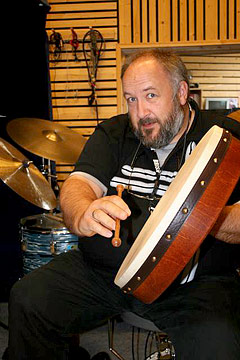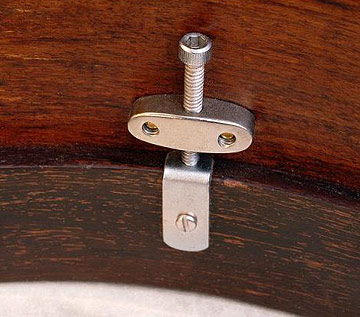

|
Drum Kit Home
BodhranDiscussion from DrumTownOther Sources |

Photo courtesy of Robert Towler |
|
Discussion from DrumTown scally: Last week when I dropped off some repaired jembes I decided to take a Bodhran as payment. It is 18" diameter and about 4" deep. The goat skinned is tacked to the shell. Mine had an inner hoop ring that can be moved by several screws to adjust the skin tension. Without this you are at the mercy of the weather and the only way to adjust the tension is to mist water on the skin to loosen it or use a blow dryer or fire to tighten the skin. Now I want to make one. Has anyone had any experience or ideas? Casper: Mine is a ply construction with a wooden cross-brace on the inside and a reinforcement ring at the top. Extremely simple in design concept. jwinecoff's son: My bodhran is fairly simple, its a plywood shell with an inner shell for extra resonance. It also has an inner ring for tuning purposes. When I was shopping for mine I was told about a couple of things to look for by my teacher in Cork. The shell is nothing special, just a ply shell will do. Most bodhrans you'll see played in pubs are 14"-18", mine is 16". The depth doesn't matter much, mine is about 4 inches deep but I know guys with ones 8 inches deep. Cross pieces are really just for show, not necessary at all; I took the ones out of my bodhran. Heads should be as thick as possible to get a nice percussive sound when you want it. There are also double and triple ply heads, stay away from those. A good, thick single ply goat skin is what you should try to get. Tuning systems are nice but not necessary. I have a tuning system in mine but I still use water to tweak it. If you want to be a purist, the Irish say Guinness Stout and a peat fire are the only things you should use to tune the head. My teacher in Ireland did something kinda strange with his drums. He attached doornobs to the inside of the shell to work as sort of a handle. Tippers are nothing special either, "tipper" in Irish means kindling, so all you need is just a stick. scally: I don't think there is any trick to the shell. As long as it is strong and stable there shouldn't be any dramas. Some steam bend a board and join it with a scarf joint. Other has 2, 3 or more plies. The quality of the drum seems to be in the skin. I have no idea how to set the tension but it will be much less than on a jembe. I'd like to see some of your tippers. There seems to be dozens of different styles. HiString: Some interesting info from jwinecoff's son. Kinda confirmed my suspicions that a ply shell is quite suitable and the mention of sizes down to 14" means that I could use the 14" mould I have for snare shells. |
|
Qjon: The Irish Bodhran is very interesting. It is easy to play, but VERY hard to play GOOD. |

Photo courtesy of Qjon |
|
scally: A friend lent me a video by Steafan Hannigan. He makes it look easy and fun. He said definitely "Do Not put Guinness on your bodhran. It is best taken internally." There appears to be a move to drums smaller than 18" and the 14 to 16" seem more popular. Dinsil: There are 2 types - actual Bodhrans, and the ones with Guinness and leprechauns printed on them that we sell to the tourists. :) winecoffj: You might be able to find a remo renaissance or fiberskyn head, but you really can't beat a real skin head. Goat is is the most popular, but I have seen kangaroo and antelope. Come to think of it, I don't I've ever seen a synthetic head bodhran thats not a remo brand piece of crap more suited for kindergarden general music classes than a session. The weather can be a problem with skin heads, but a quality head that is properly conditioned is quite more manageable that it might seem. Skin headed bodhrans also sound better the more you play them. scally: I haven't done a bodhran yet but this is what I picked up from reading on the Bodhran site. The Irish were using thick skins but changed to thin skins. Then played with double skins. The guys that make the big Lambeg drums have developed a well respected technique for preparing their skins. I think they try to get the skins a very even thickness. Their skins are popular. The fibreskins would be too thin I think. On a djembe you try to stretch the goat skin as tight as possible. That is not what they do for the bodhrans. I think they wet the skin and stretch it firmly by hand over the shell but not too tight. Then use plenty of thumb tacks to hold it in place. If you don't have enough tacks or you pulled the skin too tight you will end up tearing the skin. Thumb tacks......I know there are special ones for Taiko drums but I think the standard ones that are used for upholstery should be OK. The tuning will change with the weather. It'll be flat in high humidity/rain and high in dry/hot weather. |
|
The better bodhrans today are made with a tuning ring. This is a second ring that fits inside the shell and can be extended above the main shell
to increase tension. |

Photo courtesy of Robert Towler |
|
Other Sources jeroen: Here is a link to a german bohdran maker. He uses three plies and three rings to make it all tunable. http://www.youtube.com/watch?v=o8tvvcPaQEs scally: I found this video with Seamus O'Cane http://www.youtube.com/watch?v=JIXuL4IU2Hk I found a lot of interesting information on Paul Marshall's Bodhran forum: http://www.bodojo.com/ |